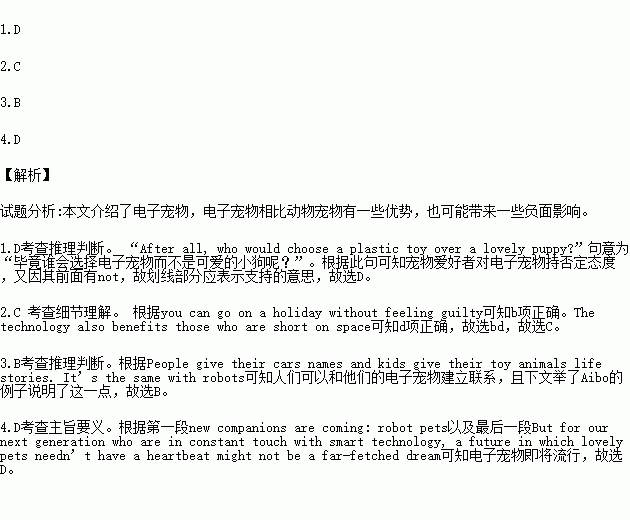题目内容
Humans have been keeping animals as pets for tens of thousands of years, but Dr Jean-Loup Rault, an animal scientist at the University of Melbourne in Australia, believes new companions are coming: robot pets.
“Technology is moving very fast,” Rault told ABC News, “The Tamagotchi in the early 1990s was really the first robotic pet, and now Sony and other big companies have improved them a lot.”
This may not sit well with pet lovers. After all, who would choose a plastic toy over a lovely puppy? But Rault argues that the robotic kind has a lot going for it: “You don’t have to feed it, you don’t have to walk it, it won’t make a mess in your house, and you can go on a holiday without feeling guilty.” The technology also benefits those who are allergic to pets, short on space, or fearful of real animals.
It’s not clear whether robot pets can replace real ones. But studies do suggest that we can bond with these smart machines. People give their cars names and kids give their toy animals life stories. It’s the same with robots. When Sony stopped its repair service for its robot dog Aibo in March 2014, owners in Japan held funerals.
As an animal welfare researcher, Rault is concerned about how robotic pets could affect our attitudes towards live animals. “If we become used to a robotic companion that doesn’t need food, water or exercises, perhaps it will change how humans care about other living beings,” he said.
So are dogs and cats a thing of the past, as Rault predicts? For those who grew up with living and breathing pets, the mechanical kind might not do. But for our next generation who are in constant touch with smart technology, a future in which lovely pets needn’t have a heartbeat might not be a far-fetched dream.
1.What does the underlined phrase “sit well with” means?
A. be refused by B. be beneficial to
C. make a difference to D. receive support from
2.What are the advantages of robot pets?
a. They are plastic and feel smooth.
b. Owners needn’t worry about them when going out.
c. They can help cure allergies(过敏).
d. They save space and costs.
A. ab B. bc C. bd D.cd
3.We can learn from the passage that___________.
A. Sony is the first company to produce robot pets Aibo.
B. People can develop strong bond(联系、关系) with their robot pets.
C. Rault thinks robot pets still have a long way to go.
D. Robot toys may help people care more about living beings.
4.The passage mainly tells us___________.
A. the advantages of robot toys
B. the popularity of robot pets
C. living pets are dying out
D. robot pets are coming
 初中学业考试导与练系列答案
初中学业考试导与练系列答案
